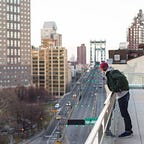Bicycles, Markets, and You
I studied Science and Technology Studies in university. It’s a strange field that explores the history and philosophy of knowledge and technology. Professors in the science and technology field are obsessed with the history of the bicycle and combining concepts that have no reason to exist together. There’s a lot of discussion of pseudoscience in STS and on how using realities or frameworks from one discipline to understand another can be dangerous and have no value. Candidly, it’s a field full of pseudoscience, contradictions, and defining obvious concepts — I wouldn't have wanted to study anything else. A background in STS is helpful when dealing with the interdisciplinary aspects of cryptographic technologies, macro & micro economic markets, and endless psyops.
In this piece we’re going to throw out all respect for reality and participate in a little pseudoscience and psyops ourselves. We’ll mix and play with concepts that have little to no reason to be combined, we’ll talk about bicycles, markets, and burn out.
How Bicycles Stay Up
Strangely, the science behind how a bicycle stays upright is almost as convoluted as the history of bicycle design. The reason that the current implementation of two-wheeled pedal technology looks like it does, is due to societal impact. We didn’t have to end up with the safety bicycle as a our primary implementation, but here we are.
Did you know that there are different types of bicycle for men and women?
Bicycles for women have a lower center support bar because they needed to be able to get on while wearing long dresses. That’s the type of ground breaking information you can learn by studying STS!
If you search for information about how bicycles stay up, you’ll find a lot of complicated descriptions of the gyroscopic effect. We’re going to throw that out the window and say that bicycles stay up because they have momentum! Bicycles stay upright because they remain in motion. It’s easy to image that if someone stopped pedaling a bicycle, they would fall over, right? So all it takes for a bicycle to stay up for another moment is one more pump. Continued pressure on the mechanism that maintains momentum allows the participant to continue their engagement without crashing.
When it comes to progress, the most important aspect is not falling apart. As long as you continue forward, you will reach your goal. As long as you can push one more time — pump yourself forward one more time — you will be fine. All that you need to do is survive and persevere. WAGMI.
On Momentum
A rising tide lifts all boats. The acceleration of gains experienced when boosted by a larger market shift can be extreme. Impacts from these effects are further exacerbated by environmental factors and meta-discourse. In high upside environments, participants often see themselves as geniuses. Attributing success to self is far easier and comfortable than recognizing uncontrollable factors and upside or access to such provided by an extended network. Success can feel as if it comes from within, when in fact it is accumulated through and supported by an exogenous network.
Smooth trails and high powered set ups create false geniuses.
False genius leads to excess and gluttony. In high acceleration environments, it’s easy to become desensitized. The speed and adrenaline of repeated successes is addicting. Few attribute their success to riding on the coattails of others. Few realize they are standing on the shoulders of giants. After riding your bicycle down a hill, coasting becomes possible. As long as you can stay upright, you can continue forward and use that momentum in your favor.
On Crashing
When I was four years old, I rode my bicycle around my parents driveway in bigger and bigger circles until eventually I ran out of driveway and found myself sitting in a creek. Things got too relaxed and my loose hands led to a less than picturesque outcome.
When you realize that your rotation is too large — or that your speed is too high — it can be overwhelming. There is a moment between high velocity and the crash that is palpable; too much to handle or control.
As the crash approaches, a stillness can be felt… an inevitability of what is about to happen. Many of us felt this in early May 2022 when the Terra ecosystem collapsed and $60b evaporated. Impacts were felt personally, by friends, by firms, and by the wider market. As it happened, it was hard to look away and it become difficult for actors to know whether they should keep pedaling or get off.
When bubbles pop, it’s messy. In times like this, it’s important to have a support system. Crashing is easier when you realize that you have support. The network that got you here is the one that can keep you here. Look around and pick each other up. This is a strange space to operate in — much of what we do feels so new but also so natural.
Tandem bicycles are not common, but neither are the crypto spaces that we operate in. Aspects of them may seem familiar but something about them is different.
0x766a878fCE194175e929EAfE0B042C52E6d6b7c9
Need something better to read? Jump back to the main branch…
